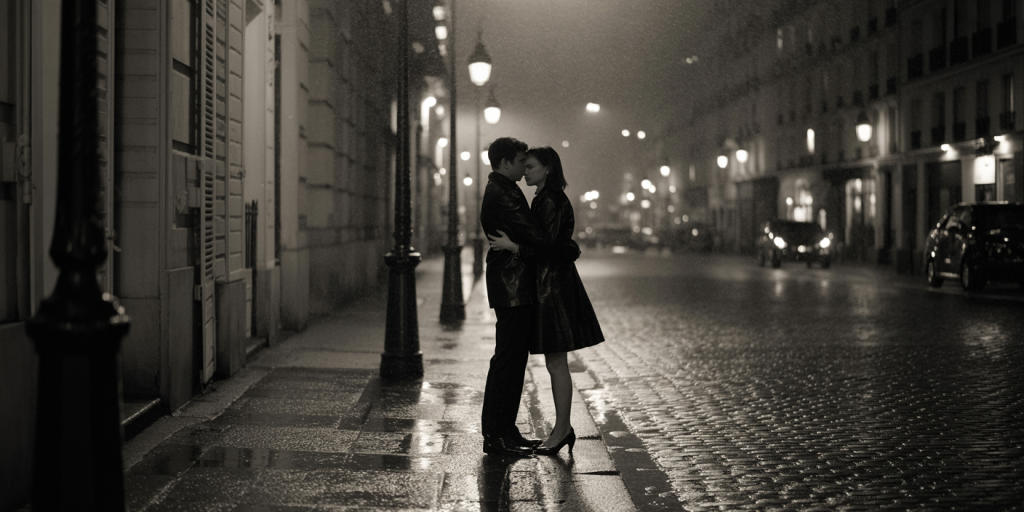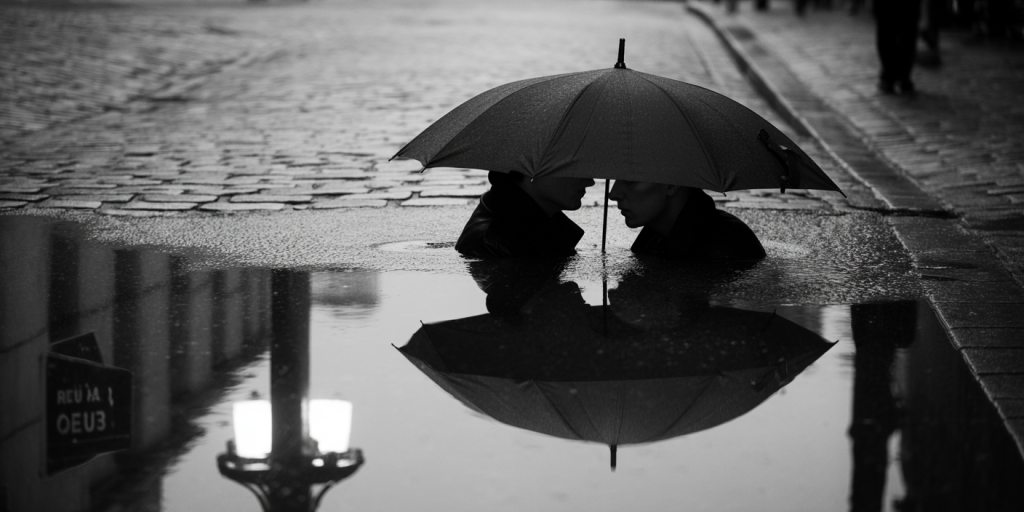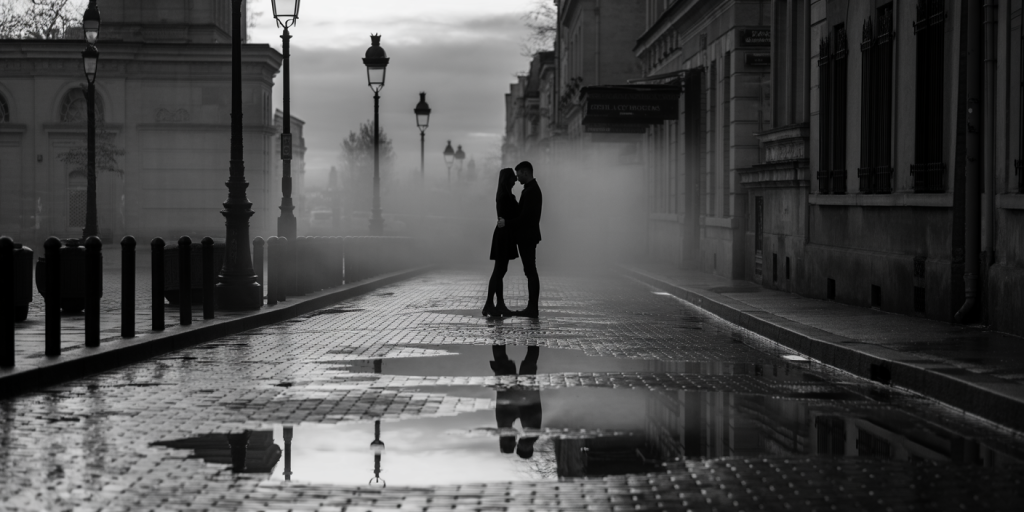Brassaï and the Reflection of Lovers in Parisian Puddles
Contemplative Opening
There are mirrors that do not hang on walls. Brassaï discovered them underfoot—fragments of sky lingering in puddles, slivers of moonlight rippling through shallow rainwater, trembling slightly beneath the hush of a kiss. In his photographs, Paris does not reflect itself in chandeliers or cathedrals, but in the quiet puddles that collect stories between cobblestones.
To gaze upon Brassaï’s lovers is not to observe intimacy—it is to overhear it. Their outlines blur into stone, dissolve into vapor, and flicker on the surface of water like a whispered vow. His lens does not steal moments—it kneels to them. And in those silver puddles, love becomes not something posed, but something found. Wet. Fleeting. Eternal.
Table of Contents
- Water as Memory
- Lovers Written in Light
- The Alchemy of Reflection
- Rain as a Composer
- Where the City Lowers Its Voice
- Silhouettes Softened by Cobblestone
- Fragments of a Parisian Dream
- Puddles as Portals
- The Curve of an Umbrella
- Light that Trembles
- When Asphalt Becomes Canvas
- Echoes of a Passing Kiss
- Black and White as Desire
- Footsteps as Metaphor
- The Romance of Wet Stone
- Intimacy in Negative Space
- Brassaï’s Ballet of Fog and Flesh
- Between Laughter and Lamp Posts
- Timelessness in a Shiver
- Final Caress on the Pavement
Water as Memory
For Brassaï, water was not mere reflection—it was remembrance. His puddles do not mirror—they remember. They preserve the moment when two bodies lean into each other, when the sky blinks between tram tracks and the street holds its breath.
In these reflections, memory becomes visible. A sidewalk glistens like the surface of thought. The past does not vanish—it pools.
Lovers Written in Light
Brassaï’s lovers are never direct subjects—they are light’s calligraphy on liquid stone. Their bodies, sometimes hidden, are traced only by shadows and silhouettes. You see them not with the eyes, but with longing.
They are not posed but proposed—gestures of affection inscribed momentarily across time’s wet skin.
The Alchemy of Reflection
Reflection, in Brassaï’s hands, is a kind of alchemy. It transforms ordinary water into goldleaf. A gutter becomes a story. A streetlamp’s glow becomes a halo. The reflection is not secondary—it is sacred.
His camera invites us to look not at the object, but at its echo.

Rain as a Composer
Rain composes the symphony in Brassaï’s Paris. It writes rhythms on the pavement, scores silence between lamplight and breath. Lovers are not merely kissed—they are composed by water.
Raindrops become punctuation. A gentle staccato under an umbrella. A lingering fermata beneath an awning.
Where the City Lowers Its Voice
In these images, the city speaks more softly. It lowers its voice around lovers. The clamor of Paris retreats. What remains are whispers—shoes brushing pavement, laughter caught in collarbones.
The buildings do not crowd—they cradle. The wet stones hush themselves to let love be heard.
Silhouettes Softened by Cobblestone
Cobblestone in Brassaï’s work is not rough—it’s velvet beneath rain. Silhouettes blur as they step. Lovers lean, and their feet disappear into shimmer. The city beneath them becomes soft, receptive.
The hardness of stone is undone by light and intimacy. Even the earth gives in to romance.
Fragments of a Parisian Dream
These photographs are not full scenes—they are fragments. Glimpses. Echoes. A shoulder caught in mirrorwater. A hand disappearing into mist. We are given not the whole, but the hush that lingers afterward.
Dreams are not sharp. They are diffused. And Brassaï’s lens blurs just enough to let the dream live.
Puddles as Portals
His puddles are more than mirrors—they are portals. They take us elsewhere. They invert the world, offering an upside-down Paris where emotion replaces logic, and form is ruled by memory.
Step into one of his puddles, and you do not get wet. You get transported.
The Curve of an Umbrella
Few forms appear more often in Brassaï’s lovers than the umbrella. It curves like an embrace. It shelters like a pause. It frames the lovers not just in shape, but in intention.
The umbrella becomes an architecture of privacy. A dome for a fleeting cathedral of affection.

Light that Trembles
The light in his photographs trembles. It never stays still. Reflected in water, distorted by motion, softened by breath—it wavers like affection in its earliest stages.
This trembling is not technical flaw—it is emotional truth. Love, too, trembles before it takes root.
When Asphalt Becomes Canvas
Brassaï turns the street into a canvas. Every raindrop a brushstroke. Every ripple, a smudge of longing. Lovers walk not on roads—but across poems made of grit and dew.
He does not photograph the city. He lets it paint itself.
Echoes of a Passing Kiss
A kiss is rarely caught in full. More often, it echoes. A blur where lips once met. A shadow where a shoulder turned. Brassaï’s images never need completion—they reverberate.
The absence of detail becomes the presence of emotion. The echo is louder than the act.
Black and White as Desire
Color is unnecessary. Desire speaks louder in contrast. Brassaï’s black and white is not nostalgic—it’s essential. It strips the image to its breath and heartbeat.
Black holds the secret. White holds the yearning. The grayscale becomes the palette of passion.
Footsteps as Metaphor
Every wet footprint is a metaphor. A mark that fades. A trace of presence. Brassaï follows those prints—not with boots, but with vision. Lovers leave more than traces—they leave texture.
A heelprint in a puddle is as sacred as a name carved in stone.
The Romance of Wet Stone
Wet stone glistens with vulnerability. It does not resist. It reveals. A sidewalk after rain is a body washed clean by feeling.
In Brassaï’s work, even stone falls in love. Especially stone.
Intimacy in Negative Space
It is not the subjects that define the frame—but the air between them. The negative space between two hands. The hush between glances. Brassaï uses absence as presence.
Love often hides in the gap—not in the grasp.

Brassaï’s Ballet of Fog and Flesh
His Paris is not only wet—it is fogged. Mist turns the city to gauze. Lovers move like dancers behind a curtain. Flesh is softened. Gesture becomes silhouette.
Fog blurs the certainty. And that blur is where tenderness lives.
Between Laughter and Lamp Posts
There’s something always between—a kiss and a pause, a streetlamp and a shoulder, a joke and a sigh. Brassaï captures that in-between. The moment not when love arrives, but just before it does.
It is a city composed of liminal joy.
Timelessness in a Shiver
A shiver of cold. A shiver of joy. A shiver from a wet heel or a wet kiss. Brassaï’s images contain time, but they never date. A wet kiss in 1932 still warms today.
Because longing, reflected in water, never ages.
Final Caress on the Pavement
As lovers drift from view, their touch lingers—not in the frame, but in the puddle. The water holds the last caress. The street remembers better than any diary.
Brassaï ends not with a farewell—but with a reflection that remains long after the lovers are gone.
FAQ – Frequently Asked Questions
Who was Brassaï?
Brassaï (1899–1984) was a Hungarian–French photographer known for his atmospheric black-and-white images of Paris by night, often exploring themes of love, intimacy, and urban life.
Why are puddles important in his work?
Puddles reflect more than images—they reflect memory, mood, and metaphor. In Brassaï’s vision, they hold not water, but time, emotion, and poetry.
Was his photography staged?
While some portraits and scenes were arranged, his street photographs—especially of lovers and puddles—were often captured spontaneously, guided by light and intuition.
What makes his style distinctive?
His use of soft contrast, attention to urban texture, and poetic framing of everyday moments created a uniquely intimate and emotional visual language.
Is his work still relevant today?
Absolutely. His images transcend time, revealing the universal longing for connection, intimacy, and beauty in ordinary spaces.
Final Reflections – When Water Becomes Memory
Brassaï did not photograph love—he listened to it. He did not capture puddles—he drank from their reflection. His Paris is not lit by neon or sun, but by the tremble of shared breath on wet stone.
To follow the steps of his lovers is to walk through a city made of longing. A place where even the water remembers. And where every reflection, no matter how fleeting, holds something eternal.
